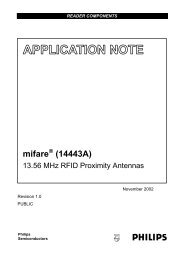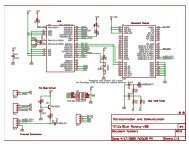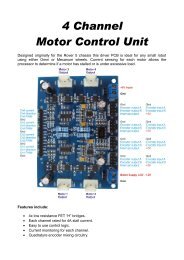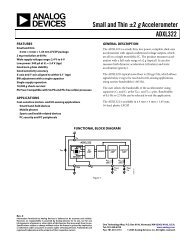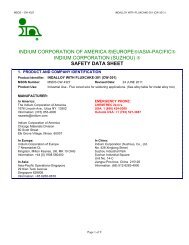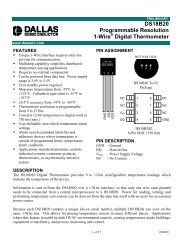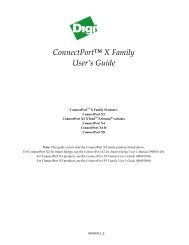u-blox 6
u-blox 6
u-blox 6
Create successful ePaper yourself
Turn your PDF publications into a flip-book with our unique Google optimized e-Paper software.
9 Power Management<br />
u-<strong>blox</strong> receivers support different power modes. These modes represent strategies of how to control the<br />
acquisition and tracking engines in order to achieve either the best possible performance or good performance<br />
with reduced power consumption.<br />
Power modes are selected using the message CFG-RXM.<br />
9.1 Maximum Performance Mode<br />
During a Cold start, a receiver in Maximum Performance Mode continuously deploys the acquisition engine to<br />
search for all satellites. Once the receiver has a position fix (or if pre-positioning information is available), the<br />
acquisition engine continues to be used to search for all visible satellites that are not being tracked.<br />
9.2 Eco Mode<br />
During a Cold start, a receiver in Eco Mode works exactly as in Maximum Performance Mode. Once a position<br />
can be calculated and a sufficient number of satellites are being tracked, the acquisition engine is powered off<br />
resulting in significant power savings. The tracking engine continuously tracks acquired satellites and acquires<br />
other available or emerging satellites.<br />
Note that even if the acquisition engine is powered off, satellites continue to be acquired.<br />
9.3 Power Save Mode<br />
Power Save Mode (PSM) allows a reduction in system power consumption by selectively switching parts of the<br />
receiver on and off.<br />
9.3.1 Operation<br />
Power Save Mode has two modes of operation: cyclic tracking and ON/OFF operation. The mode of operation<br />
can be configured directly and depending on the setting, the receiver demonstrates different behavior. In cyclic<br />
tracking the receiver does not shut down completely between fixes, but uses low power tracking instead. Cyclic<br />
tracking operation is therefore used for short update periods. In ON/OFF operation the receiver switches<br />
between normal operation and a state of low or no activity. Hence, this mode of operation is suitable for long<br />
update periods.<br />
PSM is based on a state machine with five different states: Inactive for update and Inactive for search states,<br />
Acquisition state, Tracking state and Power Optimized Tracking (POT) state.<br />
• Inactive states: Most parts of the receiver are switched off.<br />
• Acquisition state: The receiver actively searches for and acquires signals. Maximum power consumption.<br />
• Tracking state: The receiver continuously tracks and downloads data. Less power consumption than in<br />
Acquisition state.<br />
• POT state: The receiver repeatedly loops through a sequence of tracking (TRK), calculating the position fix<br />
(Calc), and entering an idle period (Idle). No new signals are acquired and no data is downloaded. Much less<br />
power consumption than in Tracking state.<br />
The following figure illustrates the state machine:<br />
GPS.G6-SW-10018-A Public Release Page 18 of 201



